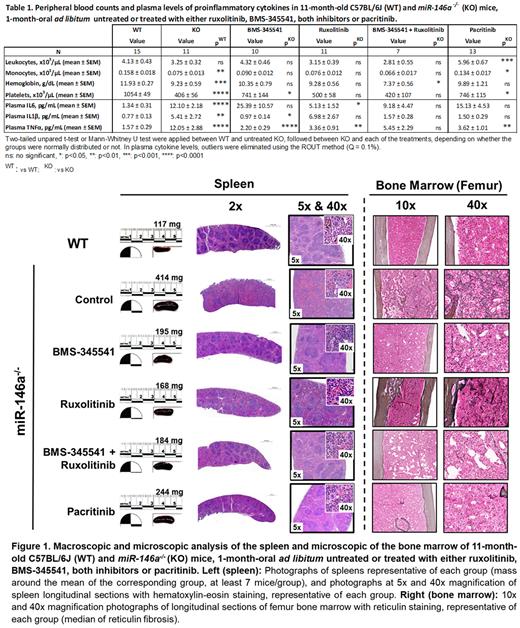Abstract
Introduction: In JAK-STAT-mediated inflammatory cytokine production in myeloproliferative neoplasms (MPN), both malignant and non-malignant clones contribute. The NF-κB pathway is a mediator of inflammation-induced carcinogenesis. We have previously demonstrated the role of miR-146a, a NF-κB repressor through IRAK1/TRAF6, in the progression of MPN. Indeed, the rs2431697 TT genotype, associated with lower miR-146a levels, contributes to early progression to secondary myelofibrosis (MF); and miR-146a-/- (KO) mice, with MF-like phenotype, show an increase in p-Stat3 with aging (Ferrer-Marin F. et al. Leukemia 2020). Here, we postulate that in this inflammation-driven MF murine model, inhibition of both NF-κB and JAK/STAT pathways can synergistically dampen the inflammatory state and reverse the MF phenotype.
Methods: 11-month-old miR-146a-/- micewere 1-month-oral ad libitum treated with either ruxolitinib (JAK1/2 inhibitor) at 75 mg/kg/day, BMS-345541 (BMS) (NF-κB pathway inhibitor at IKKα/β level) at 100 mg/kg/day, both inhibitors at the same concentrations, or pacritinib (JAK2 and NF-κB pathway inhibitor at IRAK1 level) at 150 mg/kg/day. Untreated KO and wild-type (WT) mice were used as controls (n=7-15 mice/group). We evaluated: cell counts in peripheral blood; proinflammatory plasma cytokines by Luminex; size, weight and myeloid (CD11b) and lymphoid (CD19) populations by flow cytometry in spleen; histology of spleen and bone marrow (BM) by hematoxylin-eosin and reticulin staining. SET2 cells were used as an in vitro human model of JAK2V617F clonal hematopoiesis for immunoblotting quantification of pTyrSTAT3 (JAK/STAT pathway) and IRAK1 and nuclear p-p65 (NF-κB pathway).
Results: As expected, compared to WT mice, KO mice exhibited monocytopenia, anemia and thrombocytopenia (Table 1), splenomegaly and severe reticulin fibrosis with osteosclerosis in BM (Fig.1). Moreover, in line with their inflammatory phenotype, plasma IL6, IL1β and TNFα levels were elevated in KO (vs WT) mice (Table 1). Besides splenomegaly, KO mice had spleen architecture loss, decreased white pulp and increased megakaryocytes (Fig.1), as a sign of extramedullary hematopoiesis. Consistent with histology, at a cellular level, KO mice showed significantly increased myeloid (CD11b+) and decreased lymphoid (CD19+) populations in the spleen. NF-κB pathway inhibitors (BMS and pacritinib) improved the thrombocytopenia, but only pacritinib improved monocyte counts without worsening anemia; by contrast, ruxolitinib did not improve monocytes or platelet counts, and the combination of ruxolitinib/BMS worsened anemia (Table 1). Regarding the proinflammatory cytokines, IL6 levels were significantly decreased with ruxolitinib; IL1β levels decreased whenever NF-κB pathway was inhibited, although it only showed significance with BMS; and TNFα levels significantly decreased with all treatments, with only a tendency for ruxolitinib/BMS (Table 1). Although all treatments decreased splenomegaly and partially recovered spleen architecture, only pacritinib and BMS (NF-κB inhibitors) diminished splenic megakaryocytic counts (Fig.1). NF-κB inhibitors [pacritinib and BMS (+/- ruxolitinib)] decreased the number of mice with severe reticulin fibrosis or moderate/severe osteosclerosis in the BM, whereas ruxolitinib alone did not have this effect. Unlike pacritinib, however, the combination of ruxolitinib/BMS induced BM aplasia (Fig.1). Finally, in SET2 cells, monotherapy with ruxolitinib or BMS inhibited JAK-STAT or NF-κB signaling pathways, respectively, but only pacritinib and the combination were able to inhibit both pathways.
Conclusions: miR-146a-/- mice constitute a useful model of MPN without driver mutations to evaluate the role of inflammation in these neoplasms. The dual inhibition of NF-κB and JAK/STAT with pacritinib reduced inflammatory cytokines, reverted monocytopenia and thrombocytopenia, and improved BM fibrosis without worsening anemia. While some of these benefits could be recapitulated in vivo by combining ruxolitinib with an NF-κB inhibitor, this combination resulted in worsening anemia and BM aplasia. These results highlight the therapeutic possibilities of dual JAK/NF-κB inhibitors, such as pacritinib, in patients with MF.
Funding: PI18/00316; PI20/00136; PI21/00347; 20644/JLI/18; FPU18/03189.
Disclosures
Ferrer Marin:Incyte: Research Funding.
Author notes
Asterisk with author names denotes non-ASH members.


This feature is available to Subscribers Only
Sign In or Create an Account Close Modal